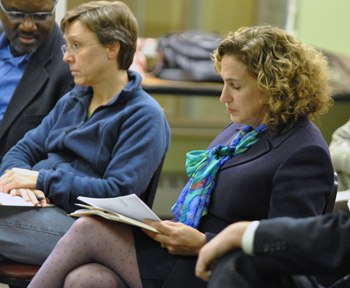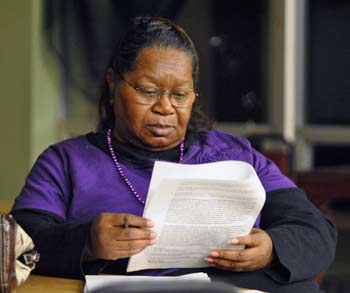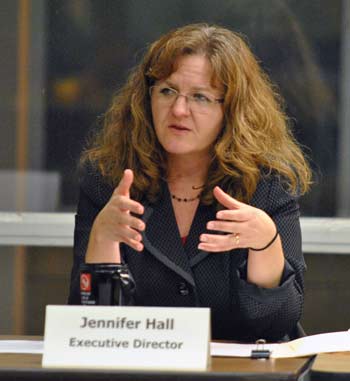Housing Commission Eyes Major Transition
Changes are underway that could be transformative for Ann Arbor’s public housing system, taking advantage of a new federal program that might result in private financing for capital improvements in aging housing stock.

Rochelle Lento, right, is an attorney with Dykema who is doing pro bono work for the Ann Arbor housing commission. Seated next to her is Margie Teall, Ward 4 city councilmember and council liaison to the commission. Next to Teall is Kevin McDonald, senior assistant city attorney. The commission’s Nov. 14 meeting was held at Miller Manor, one of the city’s public housing complexes.
The Ann Arbor housing commission is the local agency responsible for administering the city’s federally-funded public housing and Section 8 rent subsidies for low-income residents. It manages 360 public housing units, including large complexes like Baker Commons at Main and Packard. Most of its properties were built in the 1960s and 1970s, and are in need of serious maintenance and upgrades that aren’t covered by federal funding.
To address this issue, the AAHC has applied for a new program offered by the U.S. Dept. of Housing and Urban Development (HUD). The rental assistance demonstration program, known as RAD, is a mechanism to convert public housing units into public/private developments that in turn provide rental assistance through long-term Section 8 subsidy vouchers that are tied to those developments. It would also mean that ownership of some Ann Arbor public housing properties would be transferred to a new entity, in which the AAHC would have only a small ownership stake – likely 1% or less. The arrangement would give AAHC access to private financing to renovate the current public housing properties, using tax credit financing, loans, equity or grants that are not otherwise available to the housing commission.
HUD is expected to inform AAHC this month about whether it’s been selected for the program.
Last month, the housing commission board took additional action to lay the groundwork for these changes. The board approved amendments to bylaws and articles of incorporation for an AAHC nonprofit subsidiary – the Ann Arbor Housing Development Corp. – which will serve as the entity to enter into partnerships for these RAD projects. Rochelle Lento, a Dykema attorney who’s doing pro bono work for the housing commission, described it as a way to protect the AAHC from liabilities associated with entering a public/private partnership.
The five-member board will also be voting to select a co-developer and consultant for this effort, from a list of nine entities that responded to a recent request for proposals (RFP). Respondents included the local nonprofit Avalon Housing and a subsidiary of the construction firm JC Beal Construction.
The housing commission board is appointed by the Ann Arbor city council, but the council has a limited role in authorizing actions related to the RAD program. Current AAHC board members are Ron Woods, Marta Manildi, Gloria Black, Leigh Greden and Andy LaBarre.
However, at the end of the Nov. 14 meeting LaBarre announced his plans to resign from the commission. He noted that he’d recently been elected to the Washtenaw County board of commissioners, and needed to focus on what he’d been elected to do. LaBarre, a Democrat, won the District 7 seat on the county board in the Nov. 6 general election. It’s one of three districts that cover Ann Arbor. His two-year term begins in January of 2013. No nomination has yet been made for his replacement.
Ann Arbor Housing Commission: Background
The Ann Arbor housing commission manages two main programs: (1) public housing units in Ann Arbor; and (2) the Section 8 voucher program for Washtenaw, Monroe, and western Wayne counties.
For Section 8, over 1,400 vouchers are in use by tenants to subsidize rent in privately-owned properties. In addition, 37 vouchers are tied to specific projects: 20 for Avalon Housing’s Pear Street apartment complex; five for various other Avalon properties; and 12 for assisted living in units managed by Area Agency on Aging 1-B. There’s also one homeowner voucher, for an AAHC lease-to-own property.
The public housing units managed by AAHC are located throughout the city of Ann Arbor. AAHC units include Miller Manor, Baker Commons, North Maple Estates, Hikone and Hillside Manor, among several other properties. The inventory of 360 total units includes 30 single-bedroom units, 163 single-bedroom units for the elderly or disabled, 166 family units with 1-5 bedrooms, and one three-bedroom lease-to-own family unit.
Most of the AAHC housing stock was built in the 1960s and 1970s. AAHC’s most recent development – two duplexes on North Maple – was completed in 1998. Because of the aging structures, much of the cost associated with AAHC’s housing are related to maintenance. There are insufficient funds from the U.S. Department of Housing and Urban Development (HUD) to cover those costs, according to staff, so the AAHC sometimes seeks other funding sources for that work. For example, the commission recently asked the Ann Arbor Downtown Development Authority for a grant to replace the roof of Baker Commons, a 64-unit apartment complex at Main and Packard, in the DDA district. The DDA board awarded $260,000 toward that project at its October 2012 meeting.
In addition to dealing with aging housing stock and decreased federal funding, the commission’s administration and board have gone through some dramatic changes in the past three years. In 2009, the city council approved a contract with Schumaker & Company for $117,040 to conduct a needs assessment for the commission, which resulted in recommendations that led to a major reorganization. [.pdf file of the Schumaker report] The changes were prompted by difficulties with personnel and staffing issues, as well as chronic HUD underfunding. [See Chronicle coverage: "Ann Arbor Housing Commission Reorganizes"]
In March of 2010, the city council voted to dissolve the AAHC board and appointed a new board. Only one member from the previous board – Marta Manildi, who had been appointed in the fall of 2009 – was reappointed. The new commission board then hired Marge Novak in May of 2010 as executive director. Novak had been serving as interim director for about 10 months, and stayed with AAHC until July of 2011, when she resigned to take a position with an affordable housing investment firm.
A subsequent search for yet another executive director led to the hiring of Jennifer L. Hall in October of 2011. Hall had previously served as housing and infrastructure manager at the joint Washtenaw County/city of Ann Arbor office of community development.
The current board members were also serving at that time, and had voted unanimously to approve Hall’s hiring. Board members are:
- Gloria Black – resident representative. (Appointed in July 2011 for a term ending May 4, 2015.)
- Leigh Greden – former Ann Arbor city councilmember and current executive director of government and community relations at Eastern Michigan University. (Appointed in January 2011. The length of his initial appointment was made in error through May 2, 2016, according to city council records. In April 2011 council passed another resolution changing the end of his term to April 30, 2013.)
- Andy LaBarre – former aide to Congressman John Dingell and current vice president of government relations and administration at the Ann Arbor/Ypsilanti Regional Chamber of Commerce. (Appointed in August 2011 for a term ending Oct. 31, 2014. At the AAHC board’s Nov. 14 meeting, LaBarre announced his plans to resign from the board following his Nov. 6 election as a Washtenaw County commissioner.)
- Marta Manildi – attorney with Hooper, Hathaway, Price, Beuche & Wallace. (Appointed in June 2009 for a term ending May 5, 2014.)
- Ron Woods – EMU professor of Africology and African American studies. He is the current AAHC board president. His wife, Wendy Woods, is an Ann Arbor planning commissioner and former city councilmember. (Appointed in April 2010 through April 30, 2011. Reappointed in April 2011 through April 18, 2016.)
Since starting the job about a year ago, Hall has looked for ways to stabilize the organization and add to the city’s affordable housing stock. At her first AAHC board meeting in December of 2011, she proposed the possible acquisition of two properties and suggested building rental and rent-to-own units for low-income residents, with funding potentially coming from state and federal grants and loans. [See Chronicle coverage: "Ann Arbor Housing Commission to Expand?"]
Those deals did not go through, however. In one case the city was outbid, Hall told The Chronicle; in the other case, the property was not appraised at a price that the owner felt was high enough to sell.
Structural Change
The same goal of increasing the quantity and quality of the city’s low-income housing stock is also driving the current effort to restructure the AAHC, which has been in the works for months. It was mentioned during a presentation that Hall gave to the Ann Arbor city council at an Oct. 8, 2012 working session, and has been discussed at previous monthly AAHC board meetings.
The proposal aims to take advantage of HUD’s rental assistance demonstration program, known as RAD. The project is a mechanism to convert public housing units into public/private developments that in turn provide rental assistance through vouchers that are tied to those developments.
By way of background, public housing is supported with government funding – primarily at the federal level – and owned by local government entities. Another kind of government-subsidized housing – Section 8 vouchers – supports individuals who qualify based on their household income. Residents use those vouchers to help pay for private rental housing of their choice.
To a more limited degree, HUD also provides project-based vouchers. For example, the Ann Arbor housing commission has an allocation of 37 vouchers that are tied to specific projects, including 20 for Avalon Housing’s Pear Street apartment complex and 12 for assisted living in units managed by Area Agency on Aging 1-B.
The RAD program uses the project-based-voucher approach, but also allows entities like the AAHC to partner with private-sector developers on housing projects – something the AAHC currently can’t do. The approach allows public housing entities to tap private investment for new developments or rehab of existing public housing, by converting current public housing units into units that are owned by the public/private partnership.
Hall has estimated that Ann Arbor’s public housing stock would need about $40,000 per unit in repairs and renovations over the next 15 years. But based on current funding levels, HUD would provide only about $18,000 per unit over that period – or possibly less.
So Hall recommended that the AAHC apply to participate in the RAD program, with the hope of converting a large number of the current public housing complexes into public/private housing, and using private financing to help pay for improvements. Participation in the program would allow AAHC to access financing through low-income housing tax credits, FHA-backed private loans, Federal Home Loan Bank grants, and other sources.
The AAHC hopes to convert about 275 of its 360 public housing units under the RAD program. These are the properties being considered for the program, that were included in the RAD application:
- Baker Commons: 64 one-bedroom units
- Green Baxter Court: 24 townhomes with a total of 65 bedrooms
- Hikone: 30 townhomes with a total of 82 bedrooms
- Lower Platt: 4 houses, each with 5 bedrooms
- Miller Manor: 104 units with a total of 108 bedrooms
- Evelyn Court: one single-family home with three bedrooms
- Garden Circle: one single-family home with three bedrooms
- Maple Meadows: 30 townhomes with a total of 82 bedrooms
- North Maple Estates: 20 single-family homes with a total of 85 bedrooms
- North Maple duplexes: Two three-bedroom duplexes, for a total of 12 bedrooms
To help manage the conversions, the AAHC issued a request for proposals (RFP) this fall for a co-developer and consultant, with a deadline for submission of Nov. 7. [.pdf of the RFP for a co-developer and consultant]
Hall said she doesn’t have the staff to handle the paperwork and pursue funding sources for this RAD conversion, and a consultant would help with that. The co-developer would actually oversee the rehab of specific properties, and would be responsible for activities like hiring a construction team, conducting market and environmental analyses, and providing financial guarantees that are needed to secure certain types of financing.
City staff are reviewing the nine responses that were received, from the following entities: (1) Avalon Housing, (2) Recap Real Estate Advisors, (3) Union Capital Development, (4) Corporate Facts, (5) The Slavik Company & Premier Property Management, (6) Norstar Development, (7) Chesapeake Community, (8) Development Finance Association (JC Beal), and (9) MHT Housing Inc.
Structural Change: How the Conversion Would Work
To protect AAHC from liabilities associated with entering a public/private partnership, the commission plans to use an existing entity – the Ann Arbor Housing Development Corp. (AAHDC) – to handle these RAD projects. The AAHDC is a nonprofit subsidiary of the housing commission, but is essentially a shell organization at this point. It was formed in 1979 for the purpose of issuing bonds for Cranbrook Tower, a Section 8 complex off of Eisenhower with over 200 units. Cranbrook Tower is not owned by the city, but the commission was originally designated by HUD as the project’s public housing administrator. The housing commission currently receives $55,000 annually in that role.

Gloria Black, a member of the Ann Arbor housing commission who represents residents of public housing.
Now, the bonds for Cranbrook have been paid off and AAHDC is no longer needed for its original purpose. But because of Cranbrook’s original agreement with AAHDC, the commission receives $2,000 a month from the Cranbrook Tower Nonprofit Housing Corp. And those payments will continue to be made to AAHDC, Hall said. There is currently about $51,000 in a bank account for AAHDC, but the entity has no other assets and no governing board.
HUD now wants the housing commission’s administrative role in Cranbrook to be shifted to the Michigan State Housing Development Authority (MSHDA), Hall said. That still needs to happen, and will remove the housing commission and AAHDC from any formal relationship with Cranbrook, other than the monthly payments that AAHDC receives.
At the board’s Nov. 14 meeting, commissioners were briefed on these issues, and were asked to approve amendments to the AAHDC bylaws and articles of incorporation – primarily making changes that more clearly define the housing commission’s relationship with AAHDC.
Rochelle Lento, an attorney with Dykema who is doing pro bono work for the housing commission, walked commissioners through the proposed changes. The intent is to use AAHDC as a buffer between the housing commission and whatever public/private partnerships are formed under the RAD program.
For each housing project, AAHDC and its private-sector partners would create yet another entity that would be used to secure funding – tax-credit financing, grants, loans and other sources. So the housing commission would have control over AAHDC, but would not be directly involved in these other entities, which will likely be set up as limited dividend housing association LLCs. As the name implies, this type of entity would exist for a limited period – typically 15 years – after which the property’s ownership would likely revert to the AAHDC as sole owner. However, it would be possible at that point to enter into a similar arrangement for another 15-year period – that’s typically how these deals work, Hall said.
Among other things, the changes in the AAHDC bylaws and articles of incorporation make the housing commission the sole member of the AAHDC. Lento described the changes as relatively minor, with the intent of setting up a structure for the kinds of partnerships that the housing commission wants to pursue. [.pdf of amended AAHDC bylaws] [.pdf of amended AAHDC articles of incorporation]
The changes also would remove mentions of HUD’s oversight role in the AAHDC, which had been related to the Cranbrook development. The approval by housing commissioners is contingent on HUD also accepting the amended bylaws and articles of incorporation, Lento explained. She added that she’d already talked to a HUD official – Sheila Walker, the agency’s chief legal counsel – who indicated that these changes would be acceptable. Lento said she knew Walker and considered her a mentor, and didn’t feel it would be a problem to move ahead with the proposed amendments.
Commissioners asked a few clarificational questions, but there was little discussion about the proposed amendments.
Outcome: Commissioners unanimously approved the proposed amendments to the bylaws and articles of incorporation for the Ann Arbor Housing Development Corp. Leigh Greden was absent.
Next Steps
The housing commission board will be asked to make additional decisions in the coming months related to this transition. A committee that’s reviewing responses to the RFP for a co-developer and consultant will be making a recommendation to the board, possibly at its Dec. 17 meeting. The review committee includes AAHC executive director Jennifer L. Hall, AAHC board president Ron Woods, and Kevin McDonald, senior assistant city attorney.
After HUD signs off on the changes to the bylaws and articles of incorporation for the AAHDC subsidiary, the housing commission board will need to appoint a board of directors with three to seven members. The members of the AAHDC board could simply be the same as the housing commission board, Hall said – that’s up to the AAHC board members. She recommended that there be at least some overlap of board members on the two entities, to ensure communication and accountability. There will also be a memorandum of understanding prepared between the housing commission and AAHDC, setting out details about that relationship. That document would require board approval, too.
Public meetings will be held with residents to talk about the changes, though Hall said that residents wouldn’t likely notice a difference, until renovations get underway. Residents will not see their rent subsidies change as a result of this process, she said.
If the AAHC properties are accepted into the RAD program, there will also be a range of other actions that require board authorization, including the use of AAHC reserves or capital grants – possibly up to $100,000 – for gap financing, which would likely be paid back after permanent financing for these capital improvement projects is secured. In a follow-up phone interview, Hall told The Chronicle that the AAHC board already approved setting aside $100,000 of the commission’s roughly $1.5 million in reserves to use for “pre-development” activities.
The city council’s role in approving the deals is not completely clear. At the Oct. 8 city council work session about the housing commission, Ward 3 councilmember Stephen Kunselman reacted to Hall’s sketch of the RAD proposal by indicating he was not inclined to support the selling off of Ann Arbor’s public housing stock. The uncertainty of the council’s role is due to uncertainty about the ownership status of the city’s public housing, according to Hall. Until recently, it’s been assumed that the city of Ann Arbor owns the properties, in which case the city council would need to authorize any kind of ownership transfer. But HUD has indicated that it believes the properties are owned by AAHC, she said. Hall and city legal staff are working with HUD to sort out this issue, which would need to be resolved before any of these deals move forward.
The meetings of the AAHC board are typically on the third Wednesday of each month, starting at 6 p.m. and held at different public housing locations throughout Ann Arbor. The meetings are open to the public but are not videotaped or broadcast on Community Television Network. The next meeting will be held on Wednesday, Dec. 19 at North Maple Estates, 733 North Maple.
Transition of Commissioners
At the end of AAHC’s Nov. 14 meeting, Andy LaBarre announced his plans to resign from the five-member board. He noted that he’d recently been elected to the Washtenaw County board of commissioners, and needed to focus on what he’d been elected to do. He said he had enjoyed serving on the housing commission.

Andy LaBarre announced his intent to resign from the Ann Arbor housing commission board at its Nov. 14 meeting.
LaBarre, a Democrat, won the District 7 seat on the county board in the Nov. 6 general election. It’s one of three districts that cover Ann Arbor on the 9-member county board. His two-year term begins in January of 2013. He also is vice president of government relations and administration at the Ann Arbor/Ypsilanti Regional Chamber of Commerce.
Marta Manildi, the longest-serving current member of the housing commission board, told LaBarre that he had been a “very temperate and insightful colleague.” The county will benefit from his work on that board of commissioners, she said.
The housing commission board is appointed by the Ann Arbor city council, which confirms nominations made by the mayor. Jennifer L. Hall, the commission’s executive director, indicated to The Chronicle that Leigh Greden, a former city councilmember, was recruiting potential nominations. He did not attend the Nov. 14 meeting.
No nomination to replace LaBarre has yet been put forward by mayor John Hieftje. The city council meets only once more in 2012 – on Dec. 17. Typically, the nomination and confirmation occur at two separate meetings.
The Chronicle could not survive without regular voluntary subscriptions to support our coverage of public bodies like the Ann Arbor housing commission. Click this link for details: Subscribe to The Chronicle. And if you’re already supporting us, please encourage your friends, neighbors and colleagues to help support The Chronicle, too!







The idea of utilizing a public-private entity to acquire public housing isn’t a new one. It’s great to see a HUD program that encourages it finally in place. Everyone involved will ‘win’, most especially the tenants with the improved facilities. By way of background, I was the attorney for the AAHDC in connection with its creation and handling its issuance of the Section 202 bonds used to finance Cranbrook Towers. Great to see the AAHDC now being put back to good use. Congrats and best wishes to the Commission and its development team!